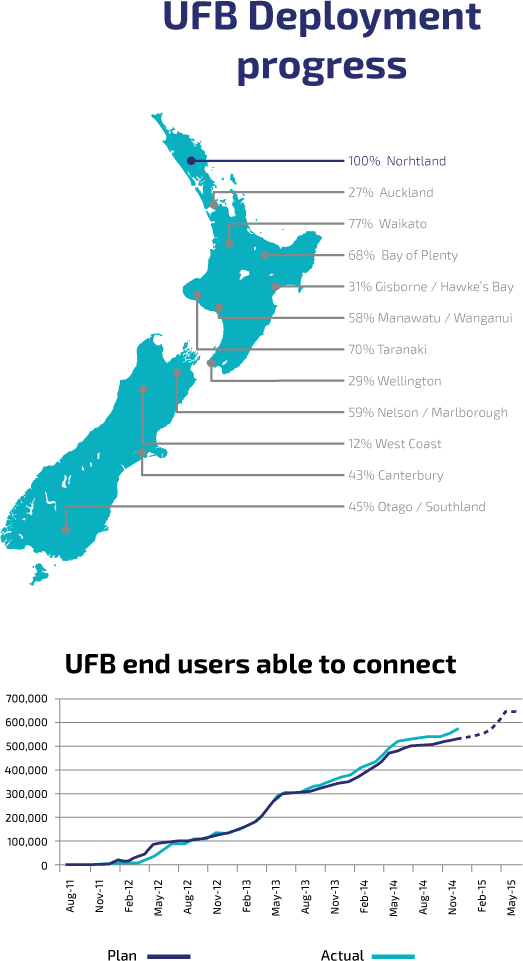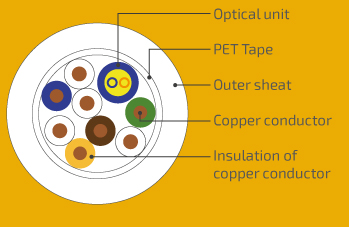Under the country’s ultra-fast broadband (UFB) plan, NZ$1.5 billion is being invested to bring broadband connections to 75% of the population over ten years. The first six years of the program focuses on priority broadband users, such as businesses, schools and health services, plus greenfield developments and certain tranches of residential areas.
Crown Fibre Holdings Ltd (CFH), the Agency established by the Government to manage the investment, has contracted with four parties. Three Local Fibre Companies (LFCs) have been created, and the fourth partnership has resulted in a newly formed Company: Chorus Ltd. This company was spun off from Telecom New Zealand in 2011, as a condition of winning the majority of the contracts for the Government’s Ultra- Fast Broadband Initiative.
Chorus is currently half way through the nine-year project. By mid-2014, a total of some 3,100km of fibre had been laid as part of the UFB programme. Fibre has been taken to 951 schools and has brought new or upgraded broadband coverage to 72,000 rural lines. Concurrent with the CFH’s UFB program is the 5-year RBI program under the MBIE. Its objective is to bring high-speed broadband to homes, schools, health providers and libraries. Chorus also strives to have a predominant position in this rural rollout:
- laying 3,350 km of fibre
- installing or upgrading over 1,000 new broadband cabinets
- connecting 183 rural libraries
- providing 100Mb/s fibre to 50 hospitals and integrated family health centres
- bringing broadband with speeds up to 100Mb/s to eligible farms, businesses and homes
Finding the right cabling solution
“ITU G.65x recommendations for fibre specifications are being followed as the base requirement for the network,” explain John McGuiness, Principal Deployment Standards Specialist and David Ong, Senior Deployment Standards Specialist, both with Chorus Network Solution Design and Standards, CTO Office. “Initially, a mixed network specification was deployed, with G.657. A2 at both ends of the network and a range of different suppliers’ G.652.D products in the middle. However, this didn’t measure up very well during UFB commissioning testing and User Acceptance Testing (UAT).
”Resolving the mode-field diameter (MFD) challenge brought an opportunity to migrate the entire UFB network to a single optimised MFD band, but this proved difficult for some incumbent cable suppliers. A decision was made to choose a single optical fibre with particular performance attributes including tight MFD range. This has to be backed by a high value brand, a reputable manufacturer with global credentials, multiple manufacturing sites and a robust supply chain. It was important to Chorus strategy that other cable manufacturers could gain access to this optical fibre.
Meeting deployment needs
“Our own investigations and support from our suppliers led us to Prysmian’s BendBrightXS. We recognised the A2 fibre was a very good example of tight design and manufacture that retains ITU compliance, secures MFD range, and adds value by improving bend resilience and performance. This results in a more uniform fibre, which brings several specific benefits to infrastructure deployment. Faster splicing without loss of quality, for example, even where rollout circumstances or handling are less than ideal. The network is fully backward-compatible with the most commonly deployed fibre (G.652.D) and can support bandwidth growth as we look toward 10GPON and 100G linking, driven by increasing trends to OTT and IPTV offerings. The possibility of integrating innovative OFDF and closure systems help reduce size, complexity and cost going forward.
”In addition, further leveraging the benefits of BendBrightXS, Chorus asked Prysmian to develop additional innovative cable designs. These included a new composite cable, which offers significant benefits in the last few metres of the network inside the buildings. Prysmian’s OptiC@t5e combines two high-quality BendBrightXS bend-insensitive optical fibres and four copper pairs (Cat 5e) inside a shared Low Smoke Halogen sheath. When the fibre connection in the street hasn’t been made yet and the service is supplied via VDSL, the Cat 5e portion is used. As soon as a user connects to the UFB fibre, BendBrightXS fibres are lit, as pre-installed and ready to be used.


